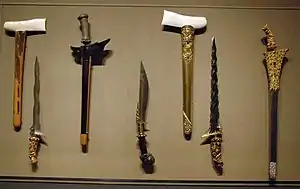| Palitai | |
|---|---|
 A Palitai, pre-1893. | |
| Type | Knife |
| Place of origin | Indonesia (Mentawai Islands) |
| Service history | |
| Used by | Mentawai people, Siberut people |
| Specifications | |
| Length | approximately 30–100 cm (12–39 in) |
| Blade type | Double edged |
| Hilt type | Wood |
| Scabbard/sheath | Wood |
Palitai (or Palite, Parittei, Pattei) is the traditional knife of the Mentawai people, originating from the Mentawai Islands[1] off West Sumatra, Indonesia.
Description

The Palitai has a straight and double edged blade. The handle is uniquely long, slim and curiously curved in shape.[2] It is a knife with a smooth blade on both edges of which are sharpened and run parallel. The edges come together at the tip to the end in a sharp point. The blade has in the middle along the entire length an elevated rib. The steel used to produce blades was imported from Sumatra, as forging was unknown on Mentawai islands. The blades were finished in the desired form on the spot. The total length may vary from 30 to 1 m (98.4 to 3.3 ft). The hilt of the Palitai is thin and long, at the blade still rather broad but becoming thinner to run long and elegantly into an almost sharp tip or decorated end. The hilt has a round thicker part just past half way. The Palitai is carried on the right, in the loin-cloth and may be part of the dowry.[3]
See also
References
- ↑ Taiwan Sheng Li Bo Wu Guan (2009). Taiwan Sheng Li Bo Wu Guan Ban Nian Kan, Volume 60. The Museum.
- ↑ George Cameron Stone (1999). A Glossary of the Construction, Decoration and Use of Arms and Armor: in All Countries and in All Times. Courier Dover Publication. ISBN 0-486-13129-7.
- ↑ Albert G Van Zonneveld (2002). Traditional Weapons of the Indonesian Archipelago. Koninklyk Instituut Voor Taal Land. ISBN 90-5450-004-2.
Further reading
- George Cameron Stone; Donald J. LaRocca (January 1999), A Glossary Of The Construction, Decoration And Use Of Arms And Armor: In All Countries And In All Times, Courier Dover Publications (published 1999), p. 367, ISBN 978-0-486-40726-5
- Waldemar Stöhr; Willy Foy; Klaus Clausmeyer (1968), Ethnologica. Neue Folge: Band 1-4, Aurel Bongers, p. 84, ASIN B0039508FU


